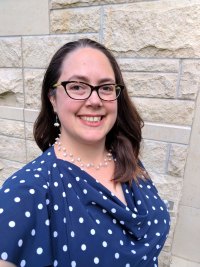NSF REU at K-State: Laser-matter Interactions at the Atomic and Nanoscales
The K-State REU program offers summer fellowships to do world-class research in our friendly physics department in the scenic Flinthills. We are funded by the National Science Foundation.
Physics Education Research (PER)
 Dr. Eleanor Sayre: DEAR-Faculty
Dr. Eleanor Sayre: DEAR-Faculty
Email: esayre@phys.ksu.edu
In the DEAR-Faculty project, we help physics faculty use research-based assessment in their classes. This is really important because assessment is a gateway drug to better teaching. The project has two parts, the "DE" part and the "AR" part.
In the "DE" part, we develop an interactive Data Explorer to help faculty interpret the results of assessments, and to compare their students to students like theirs. We work with computer scientists to write the code, and we work with physicists to collect and analyze the data. In preparation for this database, we need a summer research student to collect, concatenate, and clean up published and archival data from diverse institutions, and to connect student-level data with institution- and course-level data.
In the "AR" part, we develop Assessment Resources to teach faculty how to do assessment well. One component of our project is to provide overviews of research on each of the 50+ research-based assessment instruments in physics. We need a summer research student to collect, tag, and summarize this research.
Both of these summer projects could lead to presentations at the national meeting of the American Association of Physics Teachers in Minneapolis and potentially papers in top-tier PER journals. They will give you a broad base of knowledge about research in physics education, which will be good for future researchers as well as future teachers.
Dr. Eleanor Sayre: Network analysis
Email: esayre@phys.ksu.edu
In the Network Analysis project, we measure the "shape" of the physics education research community. As a research field, PER is relatively young. It's very rare for a new research field to develop and leave a paper trail. We are curious about how it developed and where it is going.
We couple network analytic methods with interviews and surveys of community members. Initial results suggest that the PER community, as measured by coauthorship networks, started coming together in 2006 and has been growing more intertwined ever since. We need someone to marry coauthorship data to information about mentoring relationships and analysis of research topics to investigate the spread of information in the network. This is a good project for you if you like messing about with data and you already know a little bit about programming or statistics. Work on this project could lead to a presentation at the national meeting of the American Association of Physics Teachers in Minneapolis and potentially a paper in a top-tier PER journal or in an economics journal.